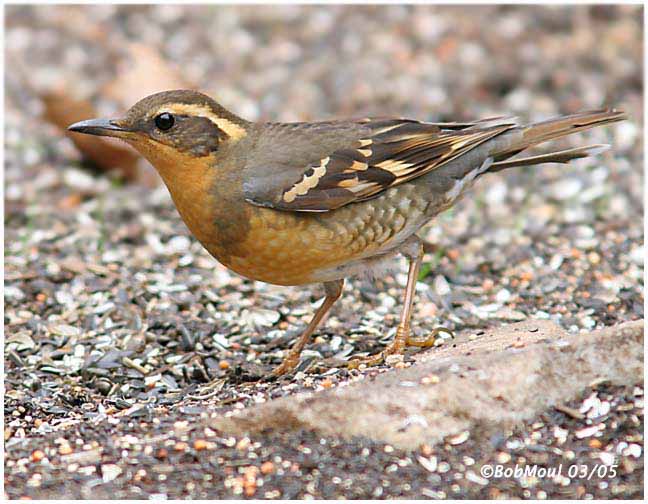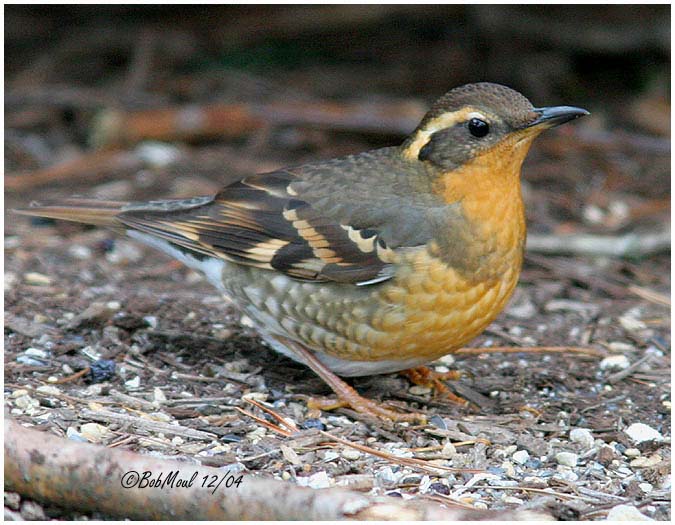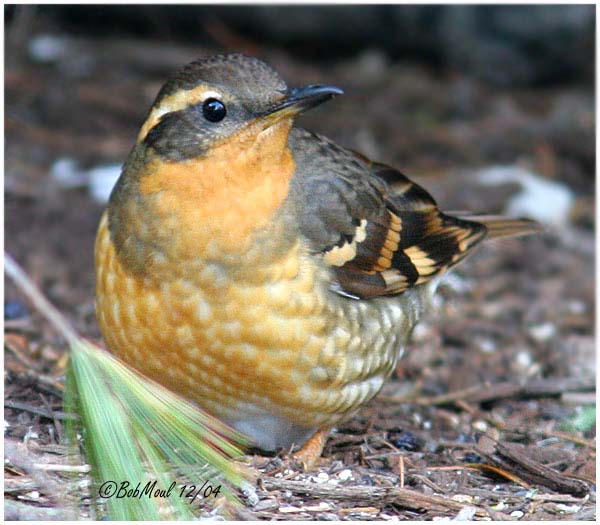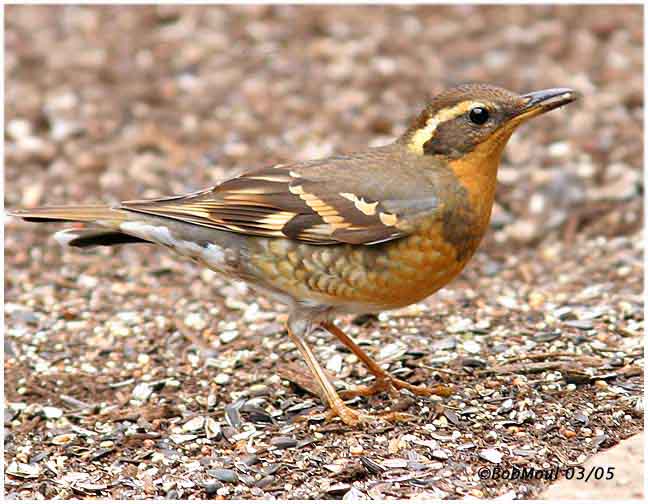
Varied Thrush
Ixoreus naevia
Passeriforme Order – Turdidae Family
BIOMETRICS:
Length: 19-26 cm ; Wingspan: 34-38 cm ; Weight: 65 à 100 g
LONGEVITY: up to 4 years
DESCRIPTION:
Varied Thrush male has greyish-blue crown, nape, back, rump and tail. Face is orange, with orange eyebrow and breast. We can see a black eye-stripe, and a blackish breast band, as a necklace. Upperwings are slate-grey with two orange wing bars, and an orange patch on opening wing. Belly is orange, slightly mottled grey, whereas the vent is whitish. Flanks are grey.
Female resembles male, but duller. Brownish-olive on upperparts replaces slate-grey of male. She has grey breast band.
Juvenile is similar to female, with whitish belly, and scale looking throat and breast.
Eyes are black. Thin and pointed bill is blackish with yellow base on lower mandible. Legs and feet are brown-orange.

VOICE: SOUNDS BY XENO-CANTO
Varied Thrush’s call is a soft and low ‘tschook”. Its song is a slow series of variously pitched notes. In spring, just before the breeding season, the male utters very sweet warbles.
HABITAT:
Varied Thrush is common in dense and moist woodlands, mainly coniferous forests. It winters in woodlands, parks and gardens.
RANGE:
Varied Thrush breeds from northern California to boreal forest in Alaska and Yukon Territory.
It winters along Alaska and British Columbia coasts to northern Idaho, and southwards to southern California.
Wanders widely cross North America in winter, to Midwestern States.

BEHAVIOUR:
Varied Thrush feeds mainly in trees, but also on the ground. It forages on ground, scratching dead leaves aside with both feet, seizing some litter in the bill, and scattering leaves in all directions. It digs with its bill through leafy debris to expose insects and earthworms, invertebrates, but also seeds, fruit and acorns. It gleans fruits from trees.
We can see the Varied Thrush sometimes wiping its bill on hard surface to clean it.
Males defend small feeding territories around bird feeders. Male performs some displays to maintain its feeding territory. When a bird comes too near, Varied Thrush raises its tail to maintain some distance between birds. If the other bird persists, it puts it head forwards, and often, the other bird retreats. But if both maintain their positions, the dominant will attack the other.
Male chooses territory to feed and to breed on the same place, in wet mature forests. It establishes it by singing. During the breeding season, Varied Thrush male will chase other males away from its territory.
Its display is agonistic. Male extends forwards, with body held in horizontal crouch, with sleeked feathers. It raises its fanned tail, spreads its wings and rotates forwards.
Varied Thrush is a partial migrant, and may winter throughout much of its range. It is a shy bird, preferring deep shade in the forest, and also dense frog and rainy weather. Generally, it keeps under shady retreat, among mosses and rocks.
FLIGHT:
Varied Thrush is a short distance migrant.
REPRODUCTION:
Varied Thrush’s nest is situated in low bushes, on or near a stream bank, or in trees at the base of branch, against the trunk.
Nest is an open cup built by female. It is made in three parts. Outer layer is made with twigs, leaves, lichen and bark. Middle layer is denser than outer, with rotten wood and moss, but sometimes with mud and wet grass. Inner layer is fine, made with soft grasses, dead leaves and moss (George-2000).

Female lays 1 to 5 greenish-blue eggs, slightly spotted with brown. Incubation lasts about 12 to 14 days, by female. Chicks hatch altricial, and they are fed by both parents. They fledge at about 13 to 15 days of age.
This species may produce two clutches per year.
DIET:
Varied Thrush feeds on insects and berries. In winter, it feeds mainly on berries, seeds and acorns. In summer, they eat insects and other invertebrates.

PROTECTION / THREATS / STATUS:
Varied Thrushes are threatened by deforestation and clear cutting, but they are not endangered in any portion of their range.
Fr: Grive à collier
All : Halsbanddrossel
Esp : Zorzal de Pecho Cinchado
Ital : Tordo variopinto
Nd : Bonte Lijster
Sd : Sitkatrast
Photographs by Bob Moul
His website:
Nature Photography
Text by Nicole Bouglouan
Sources :
HANDBOOK OF THE BIRDS OF THE WORLD Vol 10 by Josep del Hoyo-Andrew Elliott-David Christie - Lynx Edicions - ISBN: 8487334725
FIELD GUIDE TO THE BIRDS OF NORTH AMERICA - National Geographic Society - ISBN: 0792274512
All About Birds (Cornell Lab of Ornithology)
What Bird-The ultimate Bird Guide (Mitchell Waite)
Wikipedia (Wikipedia, The Free Encyclopedia)
Bird Web (Seattle Audubon Society)